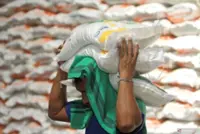
A meeting of China’s top legislative body starting on Monday is expected to unveil a financial policy package focused on stabilising the economy through local government debt swaps and injections of capital into banks, analysts said, rather than replicating the 4 trillion yuan (US$564.7 billion) stimulus of 2008 as hoped for by some market players.
They also noted that the outcome of Tuesday’s US presidential election, which is likely to become known during the five-day meeting, will play a crucial role in shaping the direction of China’s economic stimulus efforts.
While the market has been speculating about a multi-year package ranging in size from 2 trillion yuan (US$280.9 billion) to over 10 trillion yuan, economists have been tempering those expectations.
Do you have questions about the biggest topics and trends from around the world? Get the answers with SCMP Knowledge, our new platform of curated content with explainers, FAQs, analyses and infographics brought to you by our award-winning team.
“It’s pretty clear to us that policymakers just want to put a floor under the economy, rather than reflate it in any meaningful way,” said Larry Hu, chief China economist at Macquarie Capital, predicting that the stimulus will be designed to meet this year’s gross domestic product growth target while mitigating tail risks.
The National People’s Congress (NPC) Standing Committee is convening in Beijing to discuss a wide range of issues, with a potential financial stimulus package being the one that has captured the most attention.
The world’s second-largest economy is striving to reach its annual GDP growth target of “around 5 per cent” while battling a slew of economic challenges, including shrinking domestic demand, a prolonged property downturn and ballooning local government debts.
Hu said he expected Beijing to approve 6 trillion yuan for local government debt swaps over the next three years, alongside an injection of 1 trillion yuan into banks via special sovereign bonds.
He said some investors might regard such measures as “underwhelming”, but the package would be focused more on risk prevention and economic stabilisation than directly boosting demand.
“Expectations may have been too high in the first place, given the policy goal is to achieve this year’s growth target and reduce tail risks such as local government debt,” Hu added.
China fired off a policy bazooka on September 24, when the People’s Bank of China announced a larger-than-expected monetary-easing package.
It included a 0.2 percentage-point cut to the seven-day policy rate, a 0.5 percentage-point reduction in banks’ reserve requirement ratio, a slashing of the mortgage rate, and the introduction of two tools to help stabilise the stock market.
The announcement led to a rally in the domestic A-share market and prompted some to hope that a sweeping stimulus package – on par with the 4 trillion yuan stimulus of 2008 – might be forthcoming.
Ding Shuang, chief economist for Greater China at Standard Chartered, said the central government might be reluctant to raise its deficit this late in the year, and Beijing should be able to reach its economic growth target with previously announced support measures.
At a briefing last month, the Ministry of Finance pledged to allocate 400 billion yuan to boost the financial resources available to local governments and to allow the use of special government bonds to purchase unsold homes or idle land, which Ding said would provide a “notable boost” to the economy in the fourth quarter.
The official manufacturing purchasing managers’ index – a survey of sentiment among factory owners – beat expectations and rose to 50.1 in October, the National Bureau Statistics said on Thursday.
That ended five straight months of contraction, with analysts saying it was a sign that domestic demand might be recovering.
Ding also predicted more funding for local government debt swaps and bank recapitalisation in the wake of the NPC Standing Committee meeting, but stressed that such measures would “have an eye on the long-term” rather than any immediate effect.
Some of the funds might give the real economy a push, he added, as some of the cash is expected to be used to resolve unpaid debts.
“Especially when funds reach private construction firms, they start circulating within the economy, enabling these companies to pay wages and suppliers, which could be a push for the real economy,” he said.
While this week’s meeting may focus on defusing risks, Ding said the rolling out of additional incremental policies to boost consumption could be expected next year.
“This round of policy is a phased expansion in response to economic downturn and deflationary risks, in terms of the needs of the real economy,” Ding said, distinguishing it from the broad-based, flood-like stimulus that China’s top leadership has been eager to avoid.
Hu said the NPC Standing Committee meeting is unlikely to increase the central government’s fiscal deficit for this year, as local governments still have 2.3 trillion yuan in special bond issuance to play with.
“Further policy boosts will hinge on external demand,” he said, flagging the potential impact of the United States’ presidential election.
“If, for example, a new US-China trade conflict arose, leading to shrinking external demand, additional measures would become necessary, but we’re not at that point yet,” Hu said.
A new US president with a new China policy – such as the higher tariffs on Chinese goods flagged by Republican candidate Donald Trump – could pose a fresh test to China in terms of trade, technology and the overall economy.
Customs data showed the US was China’s top export market in September, with shipments up 2.16 per cent year, surpassing those to the European Union and the Association of Southeast Asian Nations.
“If [Democratic candidate Kamala] Harris is elected, US policy towards China is likely to maintain continuity, which would suggest a more moderate need for additional measures,” Ding said.
In the case of a Trump victory, however, Ding said Beijing could be expected to respond with bigger incremental measures, potentially reaching 1 to 2 per cent of China’s GDP, given the heightened external uncertainties.
Alicia Garcia-Herrero, chief economist for the Asia-Pacific region at French investment bank Natixis, said that while a stability-focused package might disappoint the market, it was needed to stave off deflation, which was mainly driven by excess supply in the real estate sector.
“The market needs to realise that these measures are something that China needs to do, because without this, its economy cannot grow,” she said.
“It’s not about growth only – it’s about avoiding a crisis or a financial stability problem.”
More from South China Morning Post:
- China’s tech factories will be a target, for Harris or Trump. Is it too late to matter?
- China’s factory activity returns to expansion, ‘positive sign’ after stimulus
- Investors await China’s NPC meeting for catalysts to sustain US$4 trillion stock rally
- Xi Jinping urges Chinese officials to make all-out effort to hit annual growth targets
- Will China cut personal income taxes as part of its stimulus drive?
For the latest news from the South China Morning Post download our mobile app. Copyright 2024.











































